Help improve the lives of your audience at scale with digital movement health programs tailored to every individual's needs and goals.
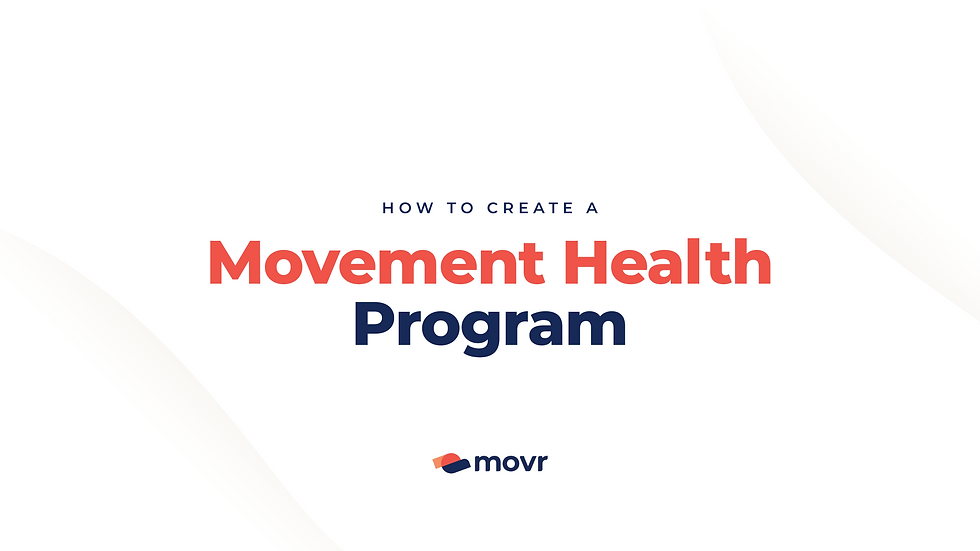
Where we are today
Today, 1 in 2 American adults suffer from movement dysfunction. 90% of US employers state musculoskeletal (MSK) issues as their top medical spend. The numbers are similar in most developed nations around the world.
Movement dysfunction can appear in a variety of ways, ranging from mildly annoying aches, tension and discomfort to the more limiting inability to perform basic functional tasks and, sometimes, even more serious acute injuries. MSK issues are often attributed to lifestyles that are too sedentary, but movement issues nonetheless persist amongst active populations, too.
What's driving these issues?
At the core, people aren’t moving enough. 125 million Americans are now considered obese, and over 80% of adolescents don’t meet recommended guidelines for physical activity.
It’s no secret, but it might still be hard to comprehend. Enabled by rapid advances in technology over the past decade – not to mention the COVID pandemic – we’ve seen a flood of fitness-related content on the market in recent years, from social media content creators to digital apps and home workout solutions. And while investment in tech has waned recently, the amount of money pouring into digital health solutions remains significant.
We’ve never been more health-focused as a society – so why are we in such rough shape? The problem isn't a lack of digital exercise options, it's the lack of the right kind of options – exercise solutions that are intelligent, highly personalized and focused on function rater than appearance.
"The problem isn't a lack of digital exercise options, it's the lack of the right kind of options – exercise solutions that are intelligent, highly personalized and focused on function rather than appearance."
While general exercise content is everywhere, little of it effectively addresses the specific needs of individuals, or the root causes of their movement limitations. Exercise options across larger populations remain largely template-driven, framed around time-worn trends like shedding fat and building muscle (fast!). Not only is this content often too generalized to be helpful, it also relies on individuals to decide for themselves what is best.
The truth is, many of us don’t really know what our bodies need to feel and function better. We rely on mainstream media and fitness influencers to inform our understanding of physical health – and the messages we get there are mixed, at best.
Until we can collectively connect the dots between our real physical health needs and the way we move our bodies each day, digital exercise options remain limited in their reach and effectiveness with the majority of the general population.
Movement health for everybody
As movement dysfunction continues to become more prevalent globally, the general population is starting to make the connection between movement health and obesity, mental health, physical resiliency and longevity through aging.
More recently, rising MSK-related costs and missed work days have incentivized larger organizations, and those that serve them, to seek out health solutions for their employees that meet the specific needs of individuals and help them feel better in their bodies, whether they are already active or not.
So what does this kind of health solution look like?
Personal movement health programs, at scale
Meaningfully improving movement health requires understanding how an individual’s body is moving and what movement limitations they may be experiencing. Only with this understanding is it possible to address the root cause of movement dysfunction and provide the guidance one needs to make a meaningful impact on how they experience their body day-to-day.
Not only does this approach better enable every individual to take ownership of their body and how they feel in it – it’s also necessary to encourage sustainable physical activity in any consumer group.
This is already standard practice with 1-on-1 physical interventions in person. Our challenge as an industry is to make it standard practice with digital solutions, too. Only then can we hope to enable meaningful health interventions at a scale great enough to help reverse growing trends of movement dysfunction.
Creating a digital movement health program
In order to implement a movement health program, whether for a single person or an entire population, we first have to agree on a few foundational principles:
Personalized instruction is the priority.
Movement health is inherently personal – every person has different needs, limitations, and aspirations
Instruction must evolve with the individual and be scalable for all.
Our bodies aren’t static – exercise recommendations must adapt to changing abilities, needs and goals that are in a constant state of flux
The program must be designed for humans (AKA the end-consumer).
Consistency is key – experiences must be framed around a long-term movement journey (not a quick fix) and keep people engaged throughout. Make the experience simple, engaging, rewarding and fun
With the right guidance, anyone* can achieve a pain-free body that supports their desired lifestyle throughout their lifetime
Movement health is the desired state of having the freedom to choose how to move your body – free of limitations, pain and injury
*People suffering from acute or chronic physical health conditions should always seek out medical attention from their doctor or physical therapist.
How to build a movement health program step-by-step:
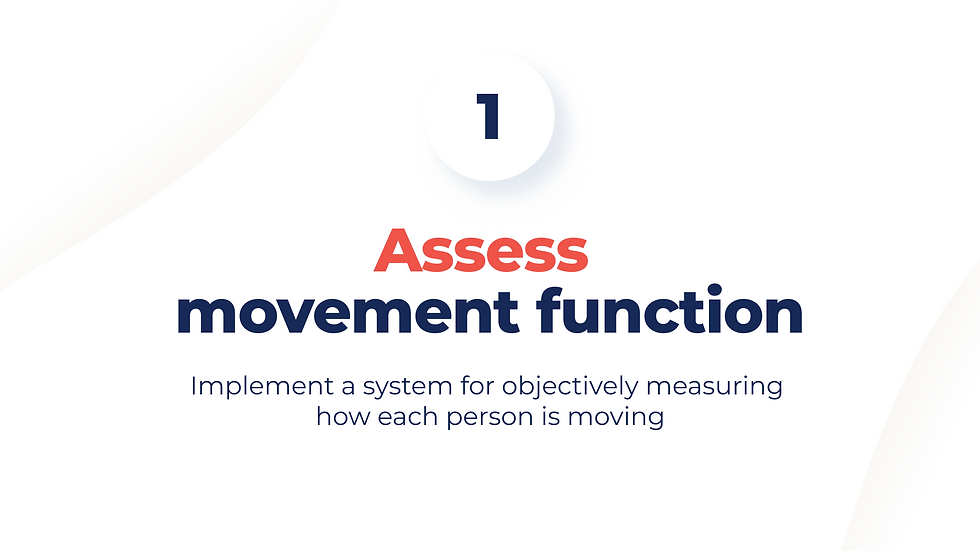
Movement assessments can come in all shapes and sizes. At their simplest, basic multiple choice questionnaires can help you gather important information about how a person is moving and feeling.
For example, questions that seek to understand how a person spends most of their day (are they on their feet, or do they sit at a desk?) can help you start to predict what imbalances they might experience. Taking a step further, direct questions about experiences of tension or pain can help determine the way you prioritize their immediate experience.
Getting a little more literal, movement assessments are an objective way to physically measure a body’s baseline. They can take the form of flexibility tests, fitness assessments, in-person FMS assessments, or digitally-enabled range of motion tests (like the kind we offer in movr).
Start by identifying the metrics that are important to you and your audience. Next, you’ll need to determine an appropriate approach for objectively measuring how people are moving and whether their body is in – or out of – balance (hint: most people, even professional athletes, have an imbalance or two that can be improved).
Whether you use questionnaires, some kind of physical movement assessment, or both (which we recommend), the information you gather at this stage is crucial for informing your understanding of each individual so that you can offer up solutions that are appropriate for their needs and effective at helping them improve.
For more information, read our article on the importance of movement assessments.

This is where you use the assessment information you’ve gathered to focus your offering and provide solutions that meet people where they really are.
For most of the population, typical exercise recommendations are too challenging or too generic to be helpful. This increases the likelihood that people will eventually disengage. At best, the content doesn’t feel relevant; at worst, it may actually negatively affect a person’s condition, making them feel worse than when they started.
Helping your users move in a full range of motion without tension, discomfort or pain is your first priority. If a person is experiencing lower back tension, for example, it’s critical to address that before moving on to tackle more advanced strength and endurance goals.
The onus is on us as healthcare providers to help our audiences understand why this is important, and how it will enable them achieve their goals more safely and effectively than ignoring the issue and trying to work around it.
Let’s be clear – prescribing the right exercises for the needs of different individuals isn’t easy. If it were – as they say – everyone would do it. In reality, safely and effectively recommending exercises is nuanced and dynamic. It’s important that your internal team has the appropriate training and expertise, or that you outsource this to a professional.
For more information, read our post about exercise prescriptions.
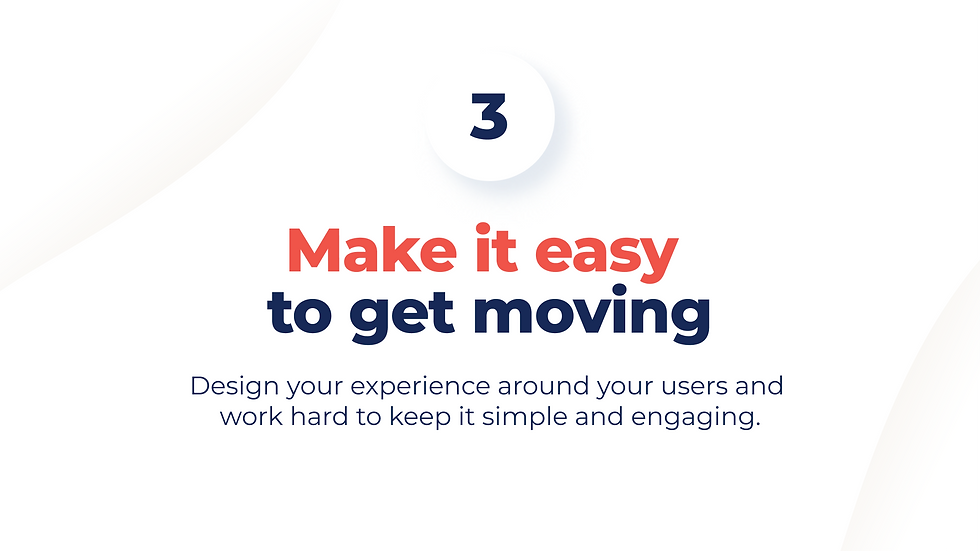
It’s no secret that getting people to consistently exercise is a challenge. The best exercise recommendations in the world won’t help if people don’t engage with them.
For this reason, it’s important to carefully craft your exercise experience and remove as many potential barriers as you can:
Frame exercise prescriptions and sessions around desired experiences.
Users are more likely to relate to outcomes (i.e. ease your lower back tension) than to the process of getting there (i.e. lower body mobility workout).
Make sessions short and accessible.
Sessions don’t always need to be long and strenuous, or even require gym equipment. A 5-minute session with the right bodyweight exercises can make a big difference.
Make the experience instantly gratifying.
Our study on the impact of the movr app found improved movement outcomes in as little as around 30 minutes a week.
When people find the right exercises – whether it’s a grandparent with back pain or an athlete recovering from injury – they can often experience instant relief. Your goal is to help people feel better in their body in as little time as possible. Help them come to see movement as a desired everyday solution rather than a chore.
Adapt programs to your audience’s evolving needs.
Life happens. Interests, needs and motivations change over time. Your solution won’t have staying power unless it evolves dynamically with each person, making space for all the steps forward and backward that they’ll inevitably experience on their health journey. Assess often and be relentless in your pursuit to personalize.
Keep things light.
Communicate often, celebrate milestones and relate when habits fall off. Reinforce the notion that moving well is a lifelong journey and not a linear path to success. Seek to become a trusted and reliable resource rather than a source of guilt.
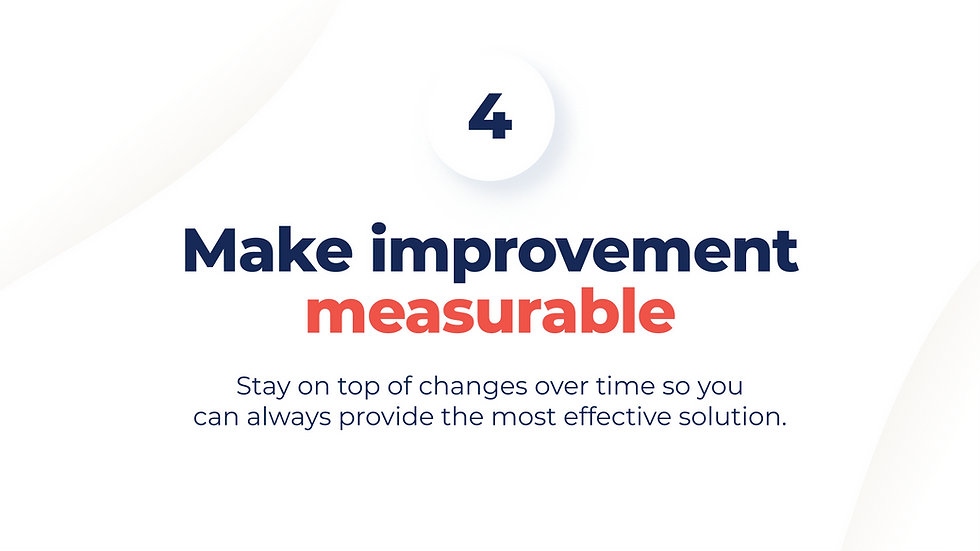
The key to making improvement sustainable is to make it measurable. In addition to benefiting your users directly by helping them understand their own progress, it also gives you continued opportunities to understand, celebrate and personalize their experience.
One of the easiest ways to measure progress over time is to continue assessing movement function throughout a user’s movement journey. Assessments are not only a great way to get an initial baseline; they’re equally effective at shedding light on how an individual’s needs evolve over time.
If you’re not assessing or measuring, you’re not able to monitor. If you’re not monitoring, there’s no way to truly know the quality or efficacy of the health interventions you’re providing.
Put in the time to implement the right assessment tool and imbed it throughout your user experience. Help your users understand the benefit to objectively assessing their movement often to create a culture that celebrates measurable progress.
For more information, read our post about measuring movement health.
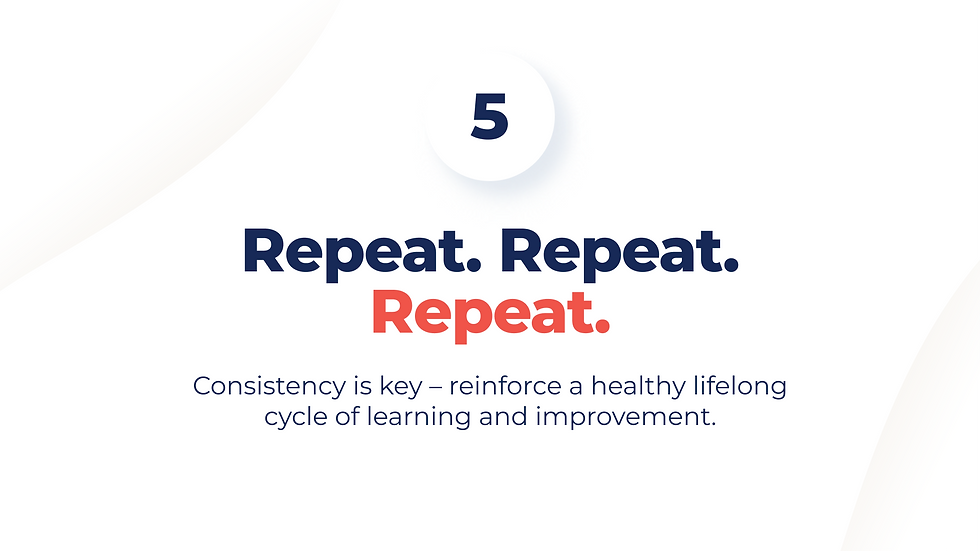
Helping people to move and feel better in their bodies doesn’t need to be overly complicated. Consistency is the key to long-term success. Focus on following the above steps to reinforce a healthy cycle of learning and improvement for both you and your user base.
A movement health program with this approach will help you enable people to experience more consistently gratifying results. It will make sustained engagement more likely and thus open the doors to other types of healthy activities that improve quality of life. That’s what movement health is all about – the freedom to choose how to move your body free of limitations, pain or injury.
Personalizing movement health – for individuals, at scale – is the new mandate. The more we collectively promote common sense measurable solutions, the better we’ll be at truly caring for people’s needs, reducing our reliance on reaction-based care and creating a better moving world for everyone.

movr is an assessment-based movement health technology company. Our goal is to help measurably improve musculoskeletal health with innovative technology solutions within an ever-changing health space.
Interested in learning more? Reach out here.


